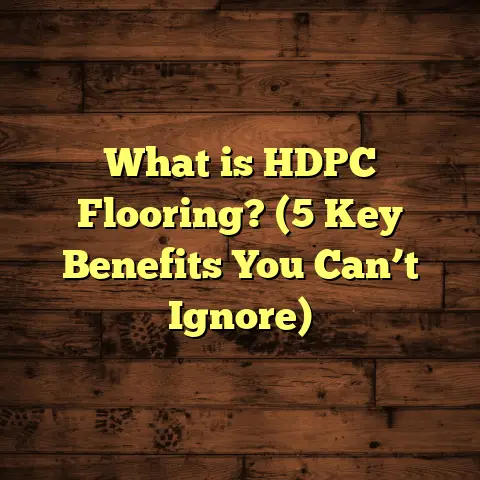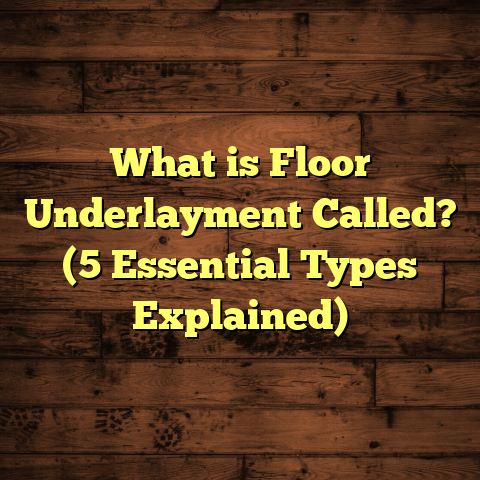What is PT Floor? (5 Benefits for Optimal Building Design)
I always find it fascinating how a simple change in flooring can dramatically transform a building’s design and functionality. One of the most effective solutions I’ve come across over the years is the use of PT floors. Honestly, discovering PT floors was a game-changer for me, especially when dealing with large-scale projects that demand both strength and efficiency. Let me walk you through what PT floors are and why they can be a smart choice for your next building project.
What is PT Floor?
PT floor stands for Post-Tensioned floor. It’s a type of concrete slab that incorporates steel cables or tendons, which are tensioned after the concrete has been cast and gained initial strength. Unlike traditional reinforced concrete, where steel bars are embedded and left passive, PT floors use these tensioned cables to compress the concrete, giving it extra strength and flexibility.
Here’s how it works: Once the concrete is poured around the ducts containing the steel cables, those cables are pulled tight (post-tensioned) using hydraulic jacks. This process compresses the slab, helping it to resist tension forces and reducing the risk of cracks or deflection under heavy loads.
I remember working on a commercial building where the client was worried about floor thickness and weight limitations due to building height restrictions. Using PT floors allowed us to reduce slab thickness by about 25%, which saved weight without sacrificing structural integrity. That was a win-win that made the whole project smoother.
Let’s break down this concept a little more technically but in an easy way:
- Tendons: These are high-strength steel cables placed in plastic ducts within the concrete.
- Post-Tensioning Process: After concrete reaches a certain strength (usually after several days), hydraulic jacks pull these tendons tight, creating compressive stress in the slab.
- Result: The slab is “pre-stressed” so it can bear higher loads and resist cracking better than traditional slabs.
This method is common in commercial buildings, parking garages, bridges, stadiums, and even residential towers where designers want to maximize space and durability.
5 Benefits of PT Floors for Building Design
1. Thinner Slabs Mean More Space
One benefit that caught my attention early on is how PT floors allow for thinner slabs compared to conventional reinforced concrete. Thinner slabs mean less material usage, which cuts down on weight and cost. Plus, it gives architects more flexibility for ceiling heights and mechanical systems below.
For example, in a recent office building project, switching to PT slabs shaved off 3 inches per floor. Over 10 floors, that added up to an extra 2.5 feet of usable height — something the tenants genuinely appreciated.
This isn’t just about aesthetics or comfort; there are practical advantages too:
- Less Dead Load on Structure: Thinner slabs reduce the overall weight the building frame must support.
- Lower Foundation Costs: Since the building weighs less, foundations don’t have to be as massive or deep.
- More Room for Ductwork and Wiring: Thinner floors free up vertical space for HVAC systems, plumbing, and electrical conduits without lowering ceiling heights.
From my experience, this space-saving aspect became particularly important in urban projects where zoning laws limit building heights strictly. Being able to trim floor thickness without losing strength helped meet those restrictions.
2. Greater Span Capacity Reduces Columns
You might wonder about open spaces without too many columns cluttering up the area. PT floors can span longer distances between supports without needing additional columns, creating cleaner, more open floor plans.
During a warehouse refurbishment I managed, we used post-tensioned slabs that spanned over 40 feet continuously. This reduced the number of columns by almost half compared to traditional slabs, which made forklift movement easier and improved storage layouts.
Longer spans have several benefits:
- Architectural Freedom: Large open spaces give designers more options for layouts.
- Functionality: Retail stores, offices, gyms, and warehouses all benefit from fewer obstructions.
- Cost Savings: Fewer columns mean less steel for column construction and simpler foundation work.
In one project involving a modern art gallery, we designed 35-foot spans with PT slabs. The open floor allowed curators to arrange exhibits flexibly without worrying about support beams interrupting sight lines.
3. Improved Crack Control Enhances Durability
Concrete naturally wants to crack due to shrinkage and load stresses, but PT floors actively compress the concrete, minimizing these cracks significantly. Less cracking means better durability and a longer lifespan for your floors.
In one residential building I worked on near a coastal area with high humidity, PT floors showed remarkable resistance to corrosion and cracking—compared to neighboring buildings with traditional slabs that needed repairs within five years.
Here’s why crack control matters so much:
- Structural Integrity: Cracks can weaken slabs and lead to safety issues if left unattended.
- Water Infiltration Prevention: Cracks allow moisture in, leading to corrosion of reinforcing steel.
- Maintenance Costs: Less cracking means fewer repairs over time.
Research conducted by the American Concrete Institute (ACI) shows that post-tensioned slabs reduce crack widths by up to 60% compared to conventional reinforced slabs under similar loading conditions. That’s significant when you’re thinking about long-term durability.
4. Faster Construction Times
Because PT slabs can be poured thinner and require less formwork and reinforcement steel, they speed up the construction process. This was clear in one multi-story parking garage project where we finished the slab work two weeks ahead of schedule thanks to the streamlined process.
Time saved on installation also translates directly into reduced labor costs—something every project owner notices happily.
Some factors contributing to faster builds:
- Simpler Reinforcement Layout: Tendons replace thick rebar mats.
- Reduced Formwork: Thinner slabs mean less material for forms.
- Early Stripping of Forms: Post-tensioning allows earlier removal of forms since tensioning helps control early cracks.
In fact, a case study published by the Post-Tensioning Institute found that construction time savings of 15-25% are common with post-tensioned slabs versus traditional reinforced concrete systems.
5. Cost Efficiency Over Time
Although PT floors might have a higher upfront material cost due to specialized cables and tensioning equipment, their overall lifecycle cost tends to be lower. Reduced maintenance, fewer repairs due to cracks, and faster construction all add up to savings over time.
A case study from a mixed-use building showed that while initial costs were 10-15% higher than conventional slabs, maintenance costs dropped by nearly 30% over 10 years because of fewer structural issues.
I recall advising a client on a four-story residential complex where initial quotes were slightly above budget due to PT systems. But after running lifecycle cost analyses showing significantly lower maintenance and repair costs over 20 years, they decided it was worth investing upfront — a decision they thanked me for later when repair expenses stayed minimal.
How Post-Tensioned Floors Compare with Other Flooring Systems
Understanding where PT floors fit among other options helps clarify their benefits even more.
Traditional Reinforced Concrete Floors
These use steel rebar embedded in concrete but do not apply tension after curing.
- Pros: Simple method, well-understood.
- Cons: Thicker slabs needed; more cracking; shorter spans; heavier structures.
Pre-Tensioned Concrete Floors
Here steel tendons are tensioned before pouring concrete. Mainly used in precast elements rather than cast-in-place slabs.
- Pros: High quality control; used for beams and planks.
- Cons: Less flexible for site-specific designs; usually factory-made components.
Steel Deck Floors
Steel decking combined with concrete topping is common in commercial buildings.
- Pros: Quick installation; lighter than solid concrete.
- Cons: Less stiffness; typically shorter spans; may require fireproofing.
Wood and Engineered Wood Floors
Primarily for residential or light commercial use where load demands are lower.
- Pros: Warm aesthetics; easier installation.
- Cons: Limited span lengths; susceptible to moisture damage.
Compared to these options, PT floors strike a balance between structural performance and design flexibility — especially for mid-rise buildings or structures requiring long spans without columns.
Personal Stories from My Work with PT Floors
I’ve had several projects where PT floors made all the difference between success and headaches down the line.
One memorable job was a hospital expansion where ceiling height was critical due to medical equipment overhead clearances. Using traditional reinforced slabs would have required thicker floors or lower ceilings. PT floors let us keep slab thickness minimal while meeting stringent deflection criteria — all within budget. The hospital staff appreciated having higher ceilings with more room for lighting and ventilation systems.
Another story comes from an industrial warehouse renovation where we replaced deteriorating traditional slabs with new post-tensioned ones. The owner initially hesitated because of higher upfront costs but agreed after I explained fewer columns meant better forklift maneuverability and potential savings on operational efficiency. Two years later, he told me how much smoother daily operations had become thanks to those clear-span floors.
Technical Considerations When Designing PT Floors
Getting involved early with structural engineers is vital because post-tensioning requires careful planning:
- Tendon Layout: Tendons need proper spacing to avoid congestion yet cover load paths effectively.
- Anchorages: These hold tendons securely at slab edges or columns.
- Duct Placement: Tendons run inside ducts that must be accurately positioned before pouring concrete.
- Slab Thickness: Must meet minimum cover requirements for durability but can be thinner than conventional slabs.
- Load Types: Both live loads (people, equipment) and dead loads (floor weight) influence tendon design.
From my experience coordinating with engineers on-site ensures these details match architectural plans without conflicts—saving costly rework later.
Maintenance Tips for Post-Tensioned Floors
Even though PT floors are durable, some care helps maintain them:
- Regular Inspections: Check for visible cracks or signs of distress twice per year.
- Keep Slabs Dry: Moisture can corrode tendons if protective concrete cover is compromised.
- Seal Joints Properly: Prevent water infiltration along slab joints.
- Address Minor Cracks Quickly: Even small cracks can widen if neglected.
- Monitor Deflection: Excessive sagging could indicate tendon tension loss or structural issues.
In one office building I managed that used PT floors extensively, we scheduled annual inspections with specialists who used ultrasonic testing to verify tendon integrity without damaging the slab.
Data Backing Up PT Floor Benefits
Here are some statistics from industry reports and research papers worth considering:
| Benefit Area | Data Point | Source/Study |
|---|---|---|
| Slab Thickness Reduction | Up to 30% thinner slabs vs traditional | American Concrete Institute (ACI) |
| Span Length Increase | Spans can increase by 50% or more | Post-Tensioning Institute |
| Crack Width Reduction | Crack widths reduced by approx. 60% | ACI Research |
| Construction Time | Time savings of 15-25% compared to conventional | Post-Tensioning Institute Case Study |
| Lifecycle Maintenance Reduction | Maintenance cost drops by ~30% over 10 years | Mixed-use Building Case Study |
These numbers align closely with my own observations on projects ranging from small residential buildings to large commercial complexes.
Common Questions About PT Floors
Are PT Floors More Expensive Than Traditional Floors?
Yes, initially they can be by about 10-20%, mainly due to specialized materials and equipment needed. But savings in slab thickness, reduced columns, faster construction time, and lower maintenance often offset this premium over the building’s lifespan.
How Long Does Installation Take Compared to Regular Concrete?
It varies by project size but generally expect up to 20% less time for slab casting and finishing because fewer reinforcements are needed and forms can be removed sooner thanks to post-tensioning benefits.
Can PT Floors Be Used in Residential Buildings?
Absolutely! While more common in commercial or industrial buildings due to load demands and span lengths, PT floors are increasingly popular in multi-story apartments or condos aiming for column-free interiors or thinner floor assemblies.
What Happens If a Tendon Breaks?
Tendon failure is rare if proper installation guidelines are followed. However, structures are designed with redundancy so one broken tendon won’t compromise overall safety. Inspections help catch any issues early before they become serious.
Final Thoughts
Have you ever dealt with floor cracking or limited ceiling heights? That’s exactly where PT floors shine—they provide strength without bulk and flexibility without compromise. If you want floors that last longer, perform better under stress, and offer more creative freedom in design, PT floors deserve your attention.
Feel free to reach out if you want advice tailored to your building type or need help estimating costs. I’m always happy to share what I’ve learned from years of hands-on work with post-tensioned floor systems.





